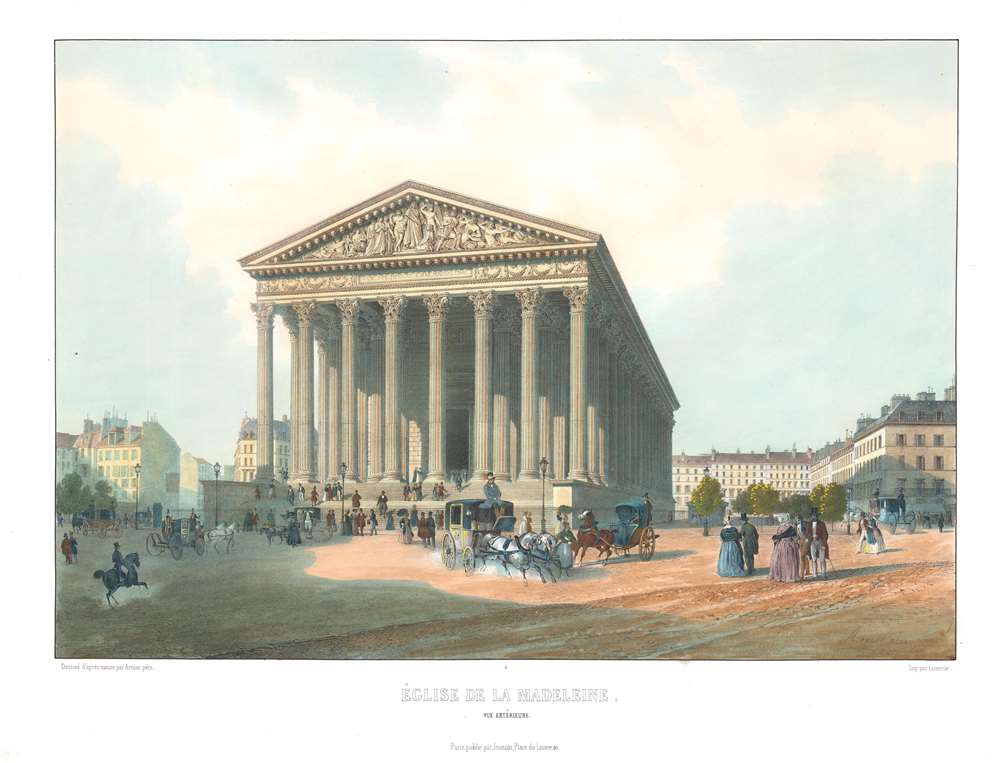This item has been sold, but you can get on the Waitlist to be notified if another example becomes available, or purchase a digital scan.
1845 Arnout View of La Madeleine, Paris, France
EgliseMadeleine-arnoutpere-1845
Title
1845 (undated) 13.5 x 17 in (34.29 x 43.18 cm)
Description
L'Église de la Madeleine
A church has stood in the neighborhood where the Madeleine now stands since 1238, when the settlement it served was not yet part of Paris, rather a village under the control of the bishop of Paris. After the city annexed this village in 1722, the government made the decision to build a grand new church to serve the neighborhood. Construction began on what became the Madeleine on August 3, 1763, when King Louis XV placed the first stone. Construction was halted due to the French Revolution, when the National Assembly officially stopped construction. During the revolutionary years, the cellar was leased to a wine seller, artisans, and other businesses. There was even a push to install the Bibliothèque nationale or the Opera there. In February 1896, the government tried to lease the building to the Banque de France, but they determined it too far from the business district. Ten months later, in December, the question of what to do with the abandoned church was finally settled by Napoleon: who converted into a temple glorifying the French army. In 1812, nonetheless, Napoleon returned to the original plan of a church. With the Bourbon Restoration after Napoleon's defeat in 1815, Louis XVIII declared that the church would become a monument to Louis XVI, Marie-Antoinette, and Madame Élisabeth. Then, following the Revolution of 1830, King Louis Philippe, made the building Paris's first train station. This idea was short-lived, with Louis Philippe, like others before him, returning building to its original intended use. The church was consecrated on October 9, 1845.Publication History and Census
This view was drawn by Jean-Baptiste Arnout, printed by Rose-Joseph Lemercier, and published by Henri Jeannin. We note only one other instance when the present view was offered on the private market and that example was uncolored. We have not located any verifiable cataloged examples in institutional collections.CartographerS
Jean-Baptiste Arnout (June 24, 1788 - October 5, 1873) was a French artist, lithographer, and engraver. Born in Dijon, Arnout is best remembered with creating a series of views of Paris, along with a beautiful series of views of the French countryside. Arnout retired in 1857. His son, Jules Arnout (June 1, 1814 - 1868) was also a successful engraver, artist, and lithographer. They collaborated on several works during the 1830s, and the younger Arnout continued working as a lithographer after his father retired. More by this mapmaker...
Rose-Joseph Lemercier (June 29, 1803 - 1887) was a French photographer, lithographer, and printer. One of the most important Parisian lithographers of the 19th century, Lemercier was born in Paris into a family of seventeen children. His father was a basket maker, and he even began working as a basket maker at the age of fifteen, but Lemercier was drawn to lithography and printing and soon entered into an apprenticeship with Langlumé, where he worked from 1822 until 1825. After working for a handful of other printers, Lemercier started his own firm in 1828 at 2, rue Pierre Sarrazin with only one printing press. He subsequently moved a few more times before arriving at 57, rue de Seine, where he founded the printing firm Lemercier and Company. He created the firm Lemercier, Bénard and Company in 1837 with Jean François Bénard. Lemercier bought out Bénard's share in the firm in 1843 and, since his two sons died at a young age, he decided to bring his nephew Alfred into the business beginning in 1862, who would progressively take on more and more responsibility in running the firm. Between 1850 and 1870, Lemercier's firm was the largest lithographic company in Paris. The firm began to decline in prestige in the early 1870s, and, after Lemercier's death in 1887, its descent only quickened. It is unclear when the firm closed, but Alfred directed the firm until his death in 1901. Learn More...
Henri Jules Jeannin (fl. 1829 - 1854) was a French print publisher active in Paris in the mid 19th century. Jeannin maintained offices at No. 20, Rue du Croissant in Paris from 1829 - 1835 and then move is office to No. 20, Place du Louvre in Paris. Little else is known about Jeannin. Learn More...

